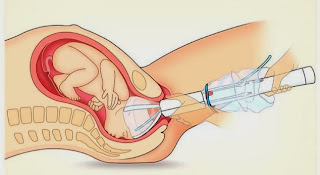Chat212 Clinic Matters's
- It is currently being tested by the World Health Organisation.
- Hospitals with poor medical facilities can used the Device to deliver babies safely when complications arise during labour
- It is safer and easier to use than forceps or a ventouse.
- Allows the midwife to slide a polythene sleeve around the baby's head, inflate it to hold it in place, and then pull the baby down the birth canal.
Chat212 - Clinic Matters's Report...Jorge Odón says the Odón Device could help deliver babies safely when complications arise during labour in areas with poor medical facilities.
 |
| It can be used to grip a baby stuck in the birth canal and pull it free |
 |
| Here Odon demonstrates how a plastic bag filled with air can be used to extract a cork from a bottle, the trick that inspired him |
 |
| The device is cheap to produce and can be used by midwives with minimal training. It is currently being tested in Argentina and rural South Africa by the World Health Organisation |
.+It+has+a+shaped+end+which+ensures+it+is+put+in+the+right+place.jpg) |
| The device has to be placed on the baby's head using an 'inserter' (pictured). It has a shaped end which ensures it is put in the right place |
 |
| Once the device is in place, the birth attendant slips a polyethylene sleeve over the babies head and inflates it to secure it in place |
.jpg) | |
| Once the sleeve is in place, the midwife can remove the plastic 'inserter' (pictured) |
 |
| The midwife can then use the sleeve to pull the baby down the birth
canal. The sleeve is lubricated meaning the baby comes out as easily as
possible |
Argentinial Ministry of Science (An Argentinian Health Mechanic) has invented a potentially life-saving device that could be used to help deliver babies when complications occur during labour.
Jorge Odón, 59, designed the instrument which could be safer than forceps, a ventouse, or a Caesarean section, in a non-hospital setting.
The Odón Device uses a polyethylene sleeve, fixed around the baby's head, to pull the child down the birth canal.
Mr Odón, who has no medical background, says he came up with the idea after seeing a YouTube video of a person removing a cork from a wine bottle using just a plastic bag.
He says that after seeing this trick, he realised the principle could also be applied to help women struggling during labour.
He says the thought hit him in the middle of the night and he woke up his wife to tell her about it, but that she just told him to go back to sleep.
Despite her dismissal, Mr Odón began work on the design and it is now the subject of a World Health Organisation approved study.
It is being tested in Argentina and in rural South Africa to establish whether it could act as a safe and feasible birth aid for use by midwives with minimal training.
If it is brought into widespread use, Mr Odón says the gadget could be the first innovation in operative vaginal delivery since the development of forceps centuries ago.
The Odón Device allows a birth attendant to place a plastic 'bell' on the baby’s head before sliding a polyethylene sleeve along the birth canal and around the baby's head.
When it is in place, a small amount of air can be pumped into the sleeve to secure it around the baby's head.
The plastic inserter is then removed and the midwife can use the sleeve to deliver the baby's head.
The sleeve is lubricated to make the delivery easier.
As the device reduces the amount of contact between the baby’s head and the birth canal it is thought it could also reduce the incidence of infections acquired during delivery.


















